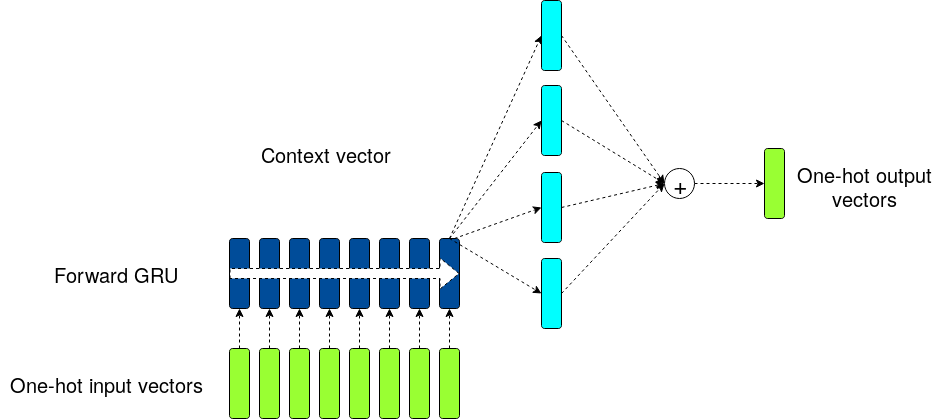In the following I try the Mixture of Softmaxes technique onto an RNN model trained on the Penn Treebank.
virtualenv --python=/usr/bin/python3 .env
source .env/bin/activate
pip install -r requirements.txtIf you need to install a GPU version
pip install -r requirements_gpu.txtThere are three models: baseline, Mixture of Softmaxes (MOS), and Mixture of Contexts (MOC)
In order to train them (it takes many hours on a GPU)
python -m mixture_of_softmax.train_baseline
python -m mixture_of_softmax.train_mos
python -m mixture_of_softmax.train_mocIn order to compute and print the validation set results (it takes a few tens of minutes)
python -m mixture_of_softmax.validate_baseline
python -m mixture_of_softmax.validate_mos
python -m mixture_of_softmax.validate_mocIn order to compute and print the test set results on the best epoch in validation (it takes a few minutes)
python -m mixture_of_softmax.test_baseline
python -m mixture_of_softmax.test_mos
python -m mixture_of_softmax.test_mocThe baseline network structure is as in Fig. 1
whereas the MOS and MOC models are depicted in Fig.2
I implemented the network described in [Tying Word Vectors and Word Classifiers]. The text is tokenized into words. A set of contiguous 35 words is fed as an input to the RNN and the 36th word is the desired output of the network. The baseline network follows the equations
where f() is the GRU function, the y1, y2, ... are one-hot encodings of the words, x1, x2,... are the low dimensional embeddings for the words, h_t are the hidden states of the RNN, and W is the matrix that transforms one-hot encodings into word embeddings (and vice-versa with the transpose of W)
The outputs z_t are to be compared to the one-hot encodings of the 36th word.
I did not use any dropout in these models
| Layer | dimension |
|---|---|
| Word embeddings | 300 |
| GRU memory | 900 |
| GRU stacks | 2 |
| Minibatch size | 20 |
| BPTT | 35 |
| MOS and MOC ensemble size | 15 |
I used the Penn Treebank Corpus for training and evaluation: Due to time constraints the training is done on 500k samples from the training set of the PTC. Each sample is composed by 35 + 1 contiguous words.
The loss function used for training is the cross entropy
where z is the network prediction and z^* is the correct label.
The models are evaluated by measuring the network's perplexity, i.e. the exponential of the loss averaged on all the testing samples.
Following [Breaking the Softmax Bottleneck] I trained three different models: The baseline model (as described before), the Mixture of Softmaxes model (MOS) and the Mixture of Contexts model (MOC).
The MOS model is effectively an ensemble method with attention: the hidden state that comes out of the RNN is dispatched into 15 different vectors by using 15 different projections matrices, each one with different initial random conditions. These 15 different vectors are then multiplied with the matrix W^\intercal creating 15 different logit vectors. Each of these logit vectors are then passed through a softmax function, provinding 15 different probability distributions for the next word. These probability distributions are then summed together using relevant attention coefficients. The MOS model is supposed to provide a better generalization.
The MOC model is still an attention model, but it is not an ensemble technique any more, because the 15 different logit vectors are summed together before the softmax function. Moreover, the attention coefficients do not provide any additional generalisation upon the baseline: Generalization comes from compression; as shown in the paper, the 15 logits vectors summed together can be mapped to a single logit vector and therefore have the same information. The MOC model is expected to perform as the baseline model.
I have tried to reproduce the results in the literature. The main difference between these models and the ones in [Breaking the Softmax Bottleneck] is the pre-sampling of the Penn Treebank Corpus. I only used half a million elements of the PTC (from ~4 million). As a result, the network has less data to learn and generalise from.
The best results are in the following table. Lowest perplexity is best.
| Model | VALID loss | VALID Perplexity | TEST LOSS | TEST Perplexity | Training Epoch |
|---|---|---|---|---|---|
| Baseline | 6.8578 | 951.33 | 6.7887 | 887.77 | 11 |
| MOS | 6.8166 | 912.92 | 6.7398 | 845.41 | 8 |
| MOC | 6.8599 | 953.31 | 6.7755 | 876.16 | 11 |
While I was not able to reproduce the exact results of [Breaking the Softmax Bottleneck] in a few days of work, the main conclusions of the paper seem effectively confirmed: The MOS model is seen generalising better than the baseline, while the MOC model is closer to the baseline than the MOS model.
It is worth noticing that the difference in the code between MOC and MOS is effectively only the position of the softmax in line 54 of the respective models:
In mos_model.py the outputs are computed using the first equation in chapter 2.4 of [Breaking the Softmax Bottleneck]
tf.reduce_sum(tf.multiply(tf.nn.softmax(self.hw_matrix), self.pi_values), axis=0)whereas in moc_model.py the outputs are computed using Eq. 2 of [Breaking the Softmax Bottleneck]
tf.nn.softmax(tf.reduce_sum(tf.multiply(self.hw_matrix, self.pi_values), axis=0))This only change is the cause of about 4% performance difference.
Finally, the poor results in terms of perplexity seem to have two causes: The pre-sampling of the training dataset, which implies less data to learn from, and the relatively low GRU memory, which seems to bring the training onto a local minimum. A bit more computational effort is needed to reproduce the results of the cited papers.

